Llangadfan is a small village in Montgomeryshire, which lies on the A458 between Foel and Llanerfyl. Dyfnant Forest, the famous rally stage, is located nearby. Just two miles north-west is the village of Garthbeibio. The men of the two villages who fell during the Great War are commemorated on a memorial plaque, which is reportedly contained in Llangadfan Primary School. I only have the list of names from the Imperial War Museum register to go by for this page, so would welcome any photographs of the memorial, and also information as to whether it is still in the school.
The Great War, 1914-1918
Richard Thomas Evans, Private, 33672, South Wales Borderers. Richard was the son of John Evans and Ann Evans (nee Lloyd), of Erw-Goch, Garthbeibio. He worked as a farm servant prior to the war. Richard enlisted at Welshpool into the army, and after completing his training was posted to the Middle East, joining the 4th Battalion, South Wales Borderers. The battalion was attached to 40 Brigade, 13th (Western) Division, and had seen heavy fighting at Gallipoli in 1915, before being evacuated to Egypt. On 15 February 1916 the Division embarked at Suez and on 4 March 1916 landed in Basra, to take part in the attempts to relieve the besieges garrison in the city of Kut. By 27 March, the Division had assembled near Sheikh Saad and came under orders of the Tigris Corps, and then took part in the attempts to relieve Kut. However, after these efforts failed and Kut fell, the British force in the theatre was built up and reorganised. The Division then fought at the Battle of Kut al Amara, then at the capture of the Hai Salient and the capture of Dahra Bend. It then took part in the passage of the Diyala, in the pursuit of the enemy towards Baghdad, and part of the Division were the first British troops to enter Baghdad. During the rest of March and April 1917, operations were undertaken to consolidate the position won at Baghdad, by pushing north across Iraq. Richard was wounded during this advance, and died of his wounds on 20 March 1917. The 20-year-old is buried in Amara War Cemetery, Iraq.
William Maldwyn Evans, Private, 41310, The Loyal North Lancashire Regiment. William was born in Oldham, Manchester in 1899, the son of Annie Evans. His mother was from Penybont, Garthbeibio, and moved back there soon after William’s birth. William worked as a sailor prior to the war. He enlisted into the 48th Battalion, Training Reserve at Birkenhead on 28 August 1917, hoping to join the Royal Welsh Fusiliers, but after completing his training, was posted to France on 30 April 1918, before being posted to the 1st Battalion, The Loyal North Lancashire Regiment. The battalion was attached to 2 Brigade, 1st Division, and William joined up with it on 6 May 1918 at Noeux-Les-Mines, near Loos. By now, this section of the Western Front had calmed down, as the Germans focussed their attention further South, on the Aisne. On 8 August 1918 a combined British, Australian and Canadian success at Villers-Bretonneux had broken the German will, and on 21 August a general offensive was launched along the Western Front. The 1st Division moved to the Arras sector by 1 September to join the great advance, launching its assault from Guemappe that morning. Just days later, the Division was moved south, to the Brie area, and bivouacked before taking part in the great advance min that sector. By 2 October the Hindenburg Line had been broken at Bellenglise, and the 1st Division had reached Sequehart. William had been wounded in the head during the fighting for the Hindenburg Line on 1 October 1918, and was hospitalised before returning to England aboard the Hospital Ship St. Andrew on 8 October. He was taken to the 4th London General Hospital at Denmark Hill, where he was found to have suffered a bullet wound to his brain, fractured skull and shattered left leg. Sadly, William died of these terrible wounds on 22 October 1918. The remains of the 19-year-old were brought home for burial in St. Tydecho’s Churchyard, Garthbeibio.
Edward Francis, Private, 61081, Royal Welsh Fusiliers. Edward was the son of Ezekiel and Susan Francis, of Penisteddfod, Llangadfan. He worked on his parent’s farm prior to the war. Edward enlisted into the 3rd Battalion, Royal Welsh Fusiliers at Welshpool, and was posted to Litherland Camp, Liverpool to join the battalion. Whilst undergoing his training, he took ill, and Edward died of disease at Liverpool on 8 March 1917. The remains of the 27-year-old were brought home for burial in Llangadfan Congregational Cemetery, Wales.
George Glover, Sergeant, 10058, King’s Shropshire Light Infantry. George was born at Hereford in 1890, the son of William James Glover and Mary Jane Glover (nee Williams). Following the death of his mother in 1913, his father came to live at Foel, Llangadfan. George had worked as a newspaper agent at Lichfield prior to enlisting at Shrewsbury into the 1st Battalion, King’s Shropshire Light Infantry, at some time before the war. At the outbreak of war, the battalion was in Tipperary, attached to 16 Brigade, 6th Division, but the entire Division was soon recalled to England before landing at St. Nazaire on 10 September 1914, and joining the BEF on the Aisne. The whole Army was then moved north into Flanders. Here the 6th Division took part in the Action of Hooge during June 1915, and in 1916 moved to the Somme, where the Division fought throughout much of the Somme offensive. By the Spring of 1917 the Division was at Arras, and fought at the Battle of Hill 70. The Division then fought during the Battle of Cambrai later in the year. In the spring of 1918, the Division was one of those hit by the German Offensive on the Somme, which had been launched on 21 March, and the took part in the Battle of St Quentin. The Division was then relieved, and went to Flanders to rest, but the following month the Germans launched another offensive on the Lys, and the Division became caught up in desperate fighting again. The 6th Division was holding the line near Dickebusch Lake, in the Ypres Salient in May 1918, and on 24 May the 1st KSLI moved into the Zillebeke Line to begin a routine tour in the trenches. On 31 May 1918 the battalion was still in the line, when a neighbouring French unit attacked the German trenches. George was killed when the Germans retaliated with an artillery barrage that day. The 24-year-old is buried in Nine Elms British Cemetery, Belgium. His brother, Jack, had been killed in 1916. Neither brother is commemorated on the Llangadfan war memorial, but are both commemorated on the Malpas memorial.
Jack Glover, Lance Corporal, G/566, The Buffs (East Kent Regiment). Jack was born at Hereford in 1890, the son of William James Glover and Mary Jane Glover (nee Williams). Following the death of his mother in 1913, his father came to live at Foel, Llangadfan. Jack worked as a groom and footman for Joseph Trueman Mills at Husbands Bosworth prior to the war. He enlisted into the army at Ashford on 31 August 1914, and was posted Canterbury, to the 6th Battalion, The Buffs (East Kent Regiment). The battalion had formed at Canterbury, before moving to Colchester and Purfleet to join 37 Brigade, 12th (Eastern) Division. Jack landed in France with the battalion on 1 June 1915, and the entire Division then took over the line at Ploegsteert Wood. The Division then moved south and fought in the Battle of Loos from 25 September, also taking part in the subsequent actions of the Hohenzollern Redoubt. The Division remained in the Loos sector until March 1916 when it was relieved and began to move south. By June the Division was in position at the Somme, and it attacked Ovillers on 2 July 1916. The Division then saw heavy fighting at Pozieres. On 1 October the 6th Buffs left a rest camp on the Amiens to Albert road, and marched via Albert to bivouacs north of Trônes and Bernafay Woods. The battalion then moved into reserve positions south of Gueudecourt, and on 6 October took over the front line near the village. On the following morning, 7 October 1916, the 6th Buffs launched a frontal assault against Gueudecourt, but suffered terrible casualties, with over 350 men killed, wounded or missing. Jack had been killed during the attack that day. The 26-year-old has no known grave and is commemorated on the Thiepval Memorial, France. His brother, George, was killed in 1918. Neither brother is commemorated on the Llangadfan war memorial, but are both commemorated on the Malpas memorial.
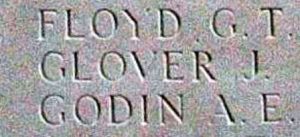
Benjamin Jones, Gunner, 171927, Royal Field Artillery. Benjamin was born in Llanrhaiadr in 1884, the son of Benjamin Jones and Maria Jones (nee Hughes). He married Charlotte Jane Evans in 1907 and the couple lived at Bryn Aber, Llangadfan. Benjamin worked as a labourer prior to the war. He enlisted into the Royal Field Artillery at Llanfyllin, and after completing his training was posted to France early in 1917, joining X/5th Trench Mortar Battery, Royal Field Artillery. The Battery was attached to the 5th Division, and was holding the line near Festubert, where it was rebuilding following heavy losses on the Somme the previous year. In March the Division transferred to the Arras sector, moving to Vimy, and the Trench Mortar Batteries were at work constructing gun pits, in preparation for the forthcoming Canadian assault on Vimy Ridge, where their main duties would be in cutting the enemy wire defences. Benjamin was most probably wounded when the gun teams came under artillery fire during the opening days of April, and he died of his wounds soon after, on 9 April 1917. The 32-year-old is buried in Barlin Communal Cemetery Extension, France.
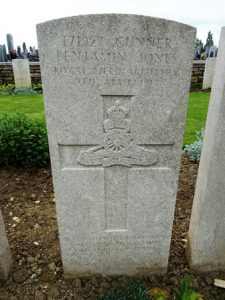
Evan Jones, Private, 204033, Royal Welsh Fusiliers. Evan was the son of David and Jane Jones, of Garthbeibio. He worked as a mason with his father. Evan married Martha Winifred Rees on 21 September 1909, and the couple lived at the Mess Room, Llymystyn, Llangadfan. He enlisted at Welshpool into the 4th Battalion, Royal Welsh Fusiliers and was posted to Park Hall Camp, Oswestry for training. Evan was posted to France in the summer of 1917, and joined the 9th Battalion, Royal Welsh Fusiliers, which was attached to 58 Brigade, 19th (Western) Division. Evan joined the 9th RWF in the Messines sector, probably after it had taken part in the Battle of Messines Ridge on 7 June. The Division saw heavy fighting for the next few days as the gains were consolidated, and Evan was probably among a draft of reinforcements following the battle. The main Ypres offensive was launched just north on 31 July 1917, and the 19th Division was in reserve while the battle opened, carrying out a scheme of training behind the lines. During the middle of September, the Division took the line again, and on 20 September the 9th RWF took part in an assault by the Division at Hessian Wood. The battalion then moved to positions at the Spoil Bank, and held the line here before the Division was relieved and moved away from Ypres. Evan had been wounded at Ypres towards the end of the Divisions tour in the Salient, and was evacuated to hospital at Rouen, where he died of his wounds on 30 November 1917, aged 30. He is buried in St. Sever Cemetery Extension, Rouen, France.
George Jones, Private, 204454, Somerset Light Infantry. George was the son of John and Mary Ellen Jones, of Tynllechwedd, Llangadfan. He worked on his parent’s farm prior to the war. George enlisted into the Montgomeryshire Yeomanry at Welshpool, and was posted to Park Hall Camp, Oswestry for training. He was posted to France in the winter of 1917-18, and transferred to the 1st Battalion, Somerset Light Infantry, which was attached to 11 Brigade, 4th Division. During March 1918 the 4th Division was in the Arras sector, holding a section of front north of The Scarpe. On 21 March 1918 the Germans launched a huge offensive along a section of Western Front running from Croisilles to La Fère, and broke through. The 4th Division was just north of the action, and saw no real fighting during this time, but nevertheless was forced to slowly withdraw. On 9 April the Germans switched their attention to a second offensive on the Lys, so the 4th Division was rushed north, taking over positions neat Mont-Bernanchon, on the La Bassée Canal, between St. Venant and Bethune, where it immediately came into contact with the enemy. Heavy fighting raged over the coming days as the line was pushed back again, and the following month the Germans switched their focus further south, to their third, and last offensive of 1918, on the Aisne. The 4th Division remained in the same positions over the summer, but following the combined British, Australian and Canadian success at Villers-Bretonneux on 8 August, from 21 August the Allies launched a massive offensive along the Western Front. The 1st Somerset Light Infantry were in the line when the offensive was launched to the south, and received orders on the following day to support an assault by the 74th (Yeomanry) Division to their left. The attack was a failure due to short warning and a lack of preparation. George had been killed during the failed attack of 22 August 1918. The 22-year-old has no known grave and is commemorated on the Loos Memorial, France. George is not commemorated on the Llangadfan and Garthbeibio war memorial.
Henry Owen Jones, Private, 203734, Royal Welsh Fusiliers. Henry was the son of David and Jane Jones, of Tanygraig, Llangadfan. He worked as a farm labourer prior to the war. Henry enlisted into the 4th Battalion, Royal Welsh Fusiliers at Welshpool on 21 January 1917, and was sent to Park Hall Camp, Oswestry for training. He had been in camp less than three weeks before he took ill, and was taken to the Camp Hospital for treatment. Henry died of broncho-pneumonia at Oswestry on 6 March 1917. The remains of the 26-year-old were brought home for burial in St. Tydecho’s Churchyard, Garthbeibio. His brother, Jonathan, died of wounds in France just two months later.
Ivor Cadvan Jones, Ordinary Seaman, J/82032, Royal Navy. Ivor was born on 23 August 1900, the son of Evan Watkin Jones and Margaret jones, of Bryngwaeddan, Llangadfan. He worked as a farm labourer prior to enlisting into the Royal Navy on 23 August 1918, and was posted to HMS Powerful for training. Powerful was an old Protected Cruiser, which had been laid up at Devonport, and was used for training Boys in the Royal Navy. Ivor took ill just over five weeks into his training, and died of Scarlet Fever at the Royal Naval Hospital, Devonport on 12 October 1918. The 18-year-old was buried in Ford Park Cemetery, Plymouth.
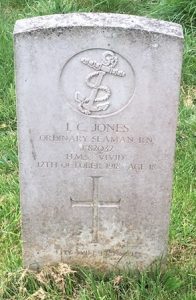
Jonathan Jones, Private, 54445, Royal Welsh Fusiliers. Jonathan was the son of David and Jane Jones, of Tanygraig, Llangadfan. He worked as a postman prior to the war. Jonathan enlisted into the Royal Welsh Fusiliers at Welshpool, and was posted to France in the winter of 1916-17, joining the 10th Battalion, Royal Welsh Fusiliers. The battalion was attached to 76 Brigade, 3rd Division, and had taken part in heavy fighting during the Somme battles, especially at Delville Wood and during a gallant assault on Serre on 13 November. The Division remained in the Serre line over the coming months, then on 6 January 1917 the 10th RWF was relieved and moved to billets at Rubempre, then Halloy. The 3rd Division then moved to the Arras Sector, to take part in the forthcoming Arras offensive. By 16 February the 10th RWF moved into the trenches at Arras to begin its first routine tour in the line. Following another brief rest, by 6 April 1917 the 10th RWF was back in the front line, and on 8 April took part in its first assault of the Battle of Arras. The weary survivors were not relieved until 14 April when the battalion moved back into Arras for a rest. By 25 April the 10th RWF moved forwards again, taking over a section of trench near Monchy, and saw heavy fighting over the coming weeks. Jonathan was wounded during this spell in the line, and was evacuated to hospital at Le Havre, where he died of his wounds on 13 May 1917. The 32-year-old is buried in Ste. Marie Cemetery, Le Havre, France. His brother, Henry Owen Jones, died whilst on active service two months later.
Meyrick Gordon Jones, Private, 206165, Machine Gun Corps (Motors). Meyrick was born at Verview Villas, Llanfair on 7 May 1886, the son of John Benjamin Jones and Annie Jones. His father was a successful wool manufacturer and by 1901 had become a Hotel Proprietor, after buying The Cann Hotel, at Llangadfan. Meyrick worked at the family hotel prior to the war. He enlisted at Welshpool into the army, and was posted to Coventry, where he joined the Motor Cycle Recruiting Section, before being posted to the Machine Gun Corps (Motors), the early formation of the Tank Corps. After completing his training, Meyrick was posted to D Company, Machine Gun Corps (Heavy Branch), which was in France, equipped with the modern, and top secret, tank. The Company first saw action on the Somme on 15 September 1916, during the Battle of Flers-Courcelette, the very first tank action in history. Meyrick survived the ordeal of the battle, but took ill before being sent to the 1st New Zealand Field Ambulance on 24 September. On the following day he was sent to the 30th Casualty Clearing Section, where he was diagnosed as suffering from with dysentery, and was then sent to hospital at Étaples. He eventually died at Étaples of dysentery on 2 November 1916. The 30-year-old was buried in Étaples Military Cemetery, France.
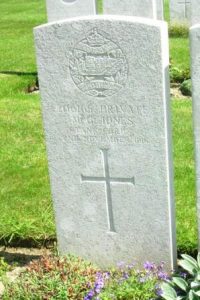
Richard Jones, Private, 110, Welsh Guards. Richard was born in Llangadfan in about 1881. He was serving with the Grenadier Guards at the outbreak of war, but following the formation of the Welsh Guards by Royal Warrant of 26 February 1915, Richard was among the first to transfer to the new regiment. The Welsh Guards took guard at Buckingham Palace for the first time on St. David’s Day, 1915. Richard landed at Le Havre with the 1st Battalion, Welsh Guards on 18 August 1915, and the battalion became attached to the newly formed 3rd Guards Brigade, Guards Division. The Division saw its first major action during the Battle of Loos, which began on 25 September 1915, and the Welsh Guards saw desperate fighting on Hill 60 two days later, suffering terrible casualties. The Guards remained in the area during the coming weeks, where they also fought in the subsequent Action of the Hohenzollern Redoubt. In the middle of November, the Guards Division moved to Merville, then held the line at Laventie and La Gorgue until 16 February 1916, when the Division moved to the Calais area. After celebrating St. David’s Day at Wormhoudt, the Guards moved into the Ypres Salient, and took over positions at Potijze. On 3 May 1916 the Welsh Guards were holding the line, when Richard and another man were killed. Richard was 35-years-old when he died that day, and is buried in Ypres Reservoir Cemetery, Belgium.
James Lloyd, Private, 24751, Royal Welsh Fusiliers. James was born in Garthbeibio in 1885, the illegitimate son of Mary Lloyd. He was raised by his grandparents, Robert and Margaret Lloyd, at Brynypistyll, while his mother married John Griffith on 5 June 1887, and moved to Llanbedrog. James worked on farms around Llangadfan from the age of 14, before moving to 16, Webster Street, Treharris prior to the war, where he worked as a haulier. He enlisted into the 16th Battalion, Royal Welsh Fusiliers at Treharris on 8 March 1915, and was posted to Llandudno to join the battalion, where it was training as part of 128 Brigade, 43rd (Welsh) Division. The Division trained in North Wales before moving to Winchester in the summer of 1915, where the formation became renumbered 113 Brigade, 38th (Welsh) Division. The Division moved to France on 2 December 1915 and moved to the Nursery Sector near Fleurbaix for trench initiation alongside the Guards Division. The Division then held a sector of the line near Cuinchy before marching south to the Somme sector in June 1916 to take part in the assault on Mametz Wood. The first attack on the wood was launched on a two-battalion front on 7 July, but failed, and the Divisional Commander, Sir Ivor Philipps, was replaced before the Division attacked again on a two Brigade front on 10 July 1916. After two days of ferocious hand-to-hand fighting, the wood was cleared up to its northern edge, before the battered Division was relieved. It then took over a section of the front at Hébuterne before moving to the Ypres Salient, and taking over the Canal Bank sector at Boesinghe. The infantry battalions of the Division then began carrying out the normal pattern of rotation in the trenches, four days in the front, four in support and four in reserve, whilst also working on trench improvement, digging new trenches, and also carrying out regular patrols and trench raids. James cut himself in the trenches on the Canal Bank, and contracted jaundice. He was evacuated to the 46th Casualty Clearing Station, near Proven, where he died of jaundice on 14 November 1916. The 31-year-old is buried in Mendinghem Military Cemetery, Belgium.
John Pryce Owen, Lance Corporal, 203235, Essex Regiment. John was the son of Pryce and Annie Owen, of Foellwyd, Garthbeibio. He enlisted at Welshpool into the Montgomeryshire Yeomanry prior to the war. On 5 August 1914 the Montgomeryshire Yeomanry was mobilised at Welshpool, as part of the South Wales Mounted Brigade, before moving via Hereford to Thetford, to join the 1st Mounted Division. John did not embark for Egypt with the regiment, but was posted to France and transferred to the 10th Battalion, Welsh Regiment during the summer of 1917. The battalion was attached to 114 Brigade, 38th (Welsh) Division and was holding the Canal Bank sector, north of Ypres. On 31 July 1917 the Division launched its famous assault on the Pilckem Ridge, capturing Iron Cross and reaching its objective of the Steenbeek, then played a supporting role in the Battle of Langemarck. The Division was transferred to the Sailly-sur-la-Lys sector in September, and remained in the area over the winter. At the end of January 1918, the 10th Welsh received the unwelcome news that it was to be disbanded and its officers and men were distributed to other units. John was transferred to the 11th Battalion, Essex Regiment, which was attached to 18 Brigade, 6th Division. The Division was holding a section of the front near Beugnatre, north-east of Bapaume, and on 21 March 1918 was hit hard when the Germans launched the first phase of their Spring offensive, along the section of front running from Croisilles to La Fère. The Division was forced to withdraw, together with the rest of the Allied line, and over the coming days reached Puisieux, before being relieved and entrained at Hondicourt for Elverdinghe on 25 March. After a brief rest, the division took over a sector of front line near Becelaere and Zillebeke Lake from 10 April. The Division remained in the Ypres Salient over the coming months, its battalions carrying out the usual routine of trench rotation. John was killed in action here during a routine spell in the line, on 31 July 1918. The 22-year-old is buried in Nine Elms British Cemetery, Belgium.
Robert Sturkey, Private, 285135, Monmouthshire Regiment. Robert was Frederick Sturkey and Elizabeth Sturkey (nee Francis), of Esgairllyn, Llangadfan. He worked as a farm servant prior to the war. Robert enlisted into the 7th Battalion, Royal Welsh Fusiliers at Welshpool on 21 November 1914. The battalion was a Territorial unit, which mobilised for war at Newtown in August 1914, as part of North Wales Brigade, Welsh Division and moved to Conway until the end of the month, before moving to Northampton. In December the Division moved to Cambridge and then in May 1915 to Bedford, where the Division was numbered and the formation became 158 Brigade, 53rd (Welsh) Division. On 19 July 1915 the entire Division sailed from Devonport for Imbros and on 9 August 1915 landed at Suvla Bay. The infantry moved off the beaches into the bush, but due to a lack of maps and no knowledge of the terrain, many of the units became disorientated, and the situation became chaotic. As the campaign wore on, the winter came, bringing floods then snow, and many men suffered from sickness and disease. Robert was invalided home, and after recovering, was posted to Park Hall Camp, Oswestry, where he took ill again, and was hospitalised there for a week in November 1916. On 13 June 1917 Robert embarked at Southampton for France, and was transferred to the 1st Battalion, Monmouthshire Regiment, before becoming attached to the 2nd Battalion, South Wales Borderers. The battalion was a regular unit which had seen action at Gallipoli and was attached to 87 Brigade, 29th Division. The Division was in the Ypres Salient when Robert arrived, and had been holding the line whilst other units had been withdrawn for specialist training, in readiness for the Third Battle of Ypres, which opened on 31 July 1917. The 29th Division went into reserve whilst the first attacks, the Battle of Pilckem Ridge, took place, then on the night of 14-15 August the 2nd SWB moved into the line facing Langemarck, ready to launch another offensive. On the following day the battalion reconnoitred the ground in front of them, and laid white tapes in No Man’s Land, to guide the attacking troops, and at dawn on 16 August 1917 the 2nd SWB launched an attack on Langemarck. The battalion successfully took its two objectives, but had suffered 163 casualties. Among the dead was 21-year-old Robert. He has no known grave and is commemorated on the Tyne Cot Memorial, Belgium.
John Richard Thomas, Private, 291241, Royal Welsh Fusiliers. John was born at Pen Capel, Llanerfyl in 1888, the son of John Thomas and Margaret Thomas (nee Richards). After the death of his father, his mother moved to Henefail, Llangadfan, while John lived at Rhydymeirch, Llanbrynmair, where he worked as a farm labourer. He enlisted into the 3/7th Battalion, Royal Welsh Fusiliers at Newtown on 20 November 1915, and was posted to Park Hall Camp, Oswestry for training. On 26 June 1916 John embarked for Egypt, and joined the 1/7th Battalion, Royal Welsh Fusiliers, which was attached to 158 Brigade, 53rd (Welsh) Division. The Division had been evacuated from Gallipoli in December 1915, moving to Egypt to join the EEF, and helped guard the Suez Canal before taking part in operations to drive the Turks out of the Sinai. The EEF then turned its attention onto driving the Turks out of Palestine, and on 26 March 1917 launched its first offensive against the coastal city of Gaza, which guarded the road to Jerusalem. Initial gains during the day were lost when the assaulting divisions lost touch with each other and communication broke down when a thick fog cloaked the battlefield. A second attempt to force Gaza was launched on 17 April, which also failed, and the EEF suffered a change in leadership, with Sir Edmund Allenby assuming command, before being re-organised, and a third offensive was launched against a wider front from Beersheba to Gaza on 31 October 1917. This time the Turkish defences were breached, and the road to Jerusalem now lay open and the EEF began to advance north. On 6 November 1917, 158 Brigade launched an attack on the Khuweilfeh Heights. John was killed in action during the fighting that day. The 29-year-old has no known grave and is commemorated on the Jerusalem Memorial, Israel. His brother, Roland, had been killed just weeks previously.
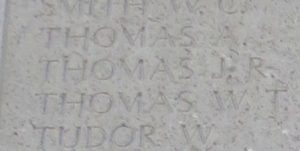
Roland Thomas, Private, 55649, Royal Welsh Fusiliers. Roland was born at Pen Capel, Llanerfyl in 1887, the son of John Thomas and Margaret Thomas (nee Richards). After the death of his father, his mother moved to Henefail, Llangadfan. Roland was married to Mary Thomas, of Frongoch, Llanfair Caereinion. Roland enlisted into the Montgomeryshire Yeomanry at Welshpool, and was subsequently transferred to the Royal Welsh Fusiliers. He was posted to France early in 1917, joining the 10th Battalion, Royal Welsh Fusiliers, which was attached to 76 Brigade, 3rd Division. In May 1917 the Division was at Arras, and fought at the First and Second Battles of the Scarpe, and then at the Battle of Arleux and at the Third Battle of the Scarpe, where the division captured Roeux. On 17 September, after a short rest behind the lines, the Division entrained for Flanders, reaching Gheluvelt the following day. The Division marched through Ypres on 25 September, and crossed the Hannebeek, before taking over a section of the line facing Zonnebeke. At 03.40 on the morning of 26 September 1917, an artillery barrage crashed onto the German lines, then the 3rd Division launched an assault on Zonnebeke, the 10th RWF with orders to follow the initial assault, then advance and take the final objective. As the men crossed the Steenbeek, they lost their bearings, but soon regained their way and reached Zonnebeke relatively unscathed. As soon as the battalion reached the Church, they came under heavy machine-gun fire, and became held up. Roland was killed in action during the fighting near Zonnebeke Church that morning. The 29-year-old has no known grave and is commemorated on the Tyne Cot Memorial, Belgium. His brother, John, was killed in Palestine just weeks later.
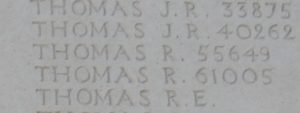
Arthur Watkin, Private, 57020, Welsh Regiment. Arthur was the son of Evan and Elizabeth Watkin, of Felinfach, Garthbeibio. He enlisted into the Montgomeryshire Yeomanry at Welshpool and was posted to Park Hall Camp, Oswestry for training. In the winter of 1916-17, Arthur was posted to France, and was transferred to the 9th Battalion, Welsh Regiment. The battalion had suffered terrible casualties during the Somme offensive, and was attached to 58 Brigade, 19th (Western) Division. The Division wintered on the Somme and in February followed the German withdrawal to the Hindenburg Line. During the middle of March 1917, the Division was relieved from the line and began to move north, taking over positions in the Ypres Salient, and on 7 June took part in the assault on Messines Ridge, which was famously preceded by the blowing of a series of 19 huge underground mines. The 19th Division saw heavy fighting during the battle, then enjoyed a short spell in reserve before moving back into the line on 11 September, taking over a section of trenches running from the Ypres-Comines Canal to Belgian Wood. On 20 September the 9th Welsh took part in an attack by the Division, past Hollebeke Chateau, to Hessian Wood. The 9th Welsh alone suffered around 300 casualties during the costly attack. Arthur was probably wounded around this time, as he returned to Britain for treatment. Upon recovering he re-joined the 9th Welsh, by which time had moved with the 19th Division to the Cambrai sector, following the closure of the Battle of Cambrai, and was holding a section of the line in the Flesquières Salient. On 21 March 1918 the Germans launched the first of three offensives on to the section of the front running from Flesquières to St. Quentin, and the 19th Division was thrown into desperate fighting as it was pushed back over the coming days. The battered Division was then moved to the Messines sector to rest, but on 11 April became caught up in the second phase of the German offensive, which had been launched along the Lys Valley on 9 April, and again became caught up in desperate fighting. The remnants of the Division were moved south to the Aisne sector to rest and rebuild, but by sheer bad luck, the Germans third, and last, offensive was launched here on 27 May 1918, and the Division was once more caught up in desperate fighting. Arthur was taken prisoner by the Germans at some time during the desperate fighting of the Spring Offensives, and was taken to a PoW Camp in Altdamm, Stettin, Prussia (now in Poland). He died of wounds as a PoW on 19 May 1918, aged 22. Arthur is buried in Berlin South-Western Cemetery, Germany.
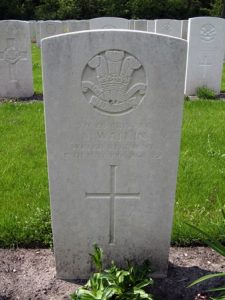
World War Two, 1939-1945
Albert Evans, Private, 4195070, Pioneer Corps. Albert was the son of Edward Evans and Jane Evans (nee Roberts), of Llangadfan. He enlisted into the army and was posted to the Pioneer Corps. Very little else is known of Albert, but he was probably posted to North Africa, before taking part in the invasion of mainland Italy. Albert was killed at Anzio on 12 March 1944, aged 24. He is buried in Beach Head War Cemetery, Anzio, Italy. It is not known if there are any WW2 names on the Llangadfan war memorial.